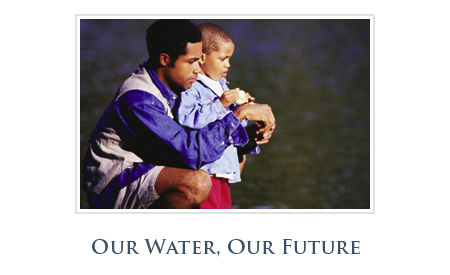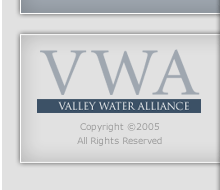
California's Central Valley was built around its agricultural industry and the development of irrigated agriculture. Today it is so much more, a land alive with a bustling array of commerce supporting a rapidly growing population made possible by adequate supplies of water.
Water has always been the key. More than 70 years ago, what we now know as the Central Valley Project and its Friant Division, were initiated by the State of California and later developed by the U.S. Bureau of Reclamation to restore water reliability within a region where the agriculture base was declining as a result of diminishing groundwater supplies.
Construction of Friant Dam and the Friant-Kern and Madera canals ultimately transformed the central and southern San Joaquin Valley into not only an incredibly productive agriculture region but a thriving and diversified economy. The five county region supported by Friant water is now home to more than 1.25 million residents.
While agriculture and its many support industries and businesses are still important, a growing percentage of the economy is now made up of manufacturing, hospitality, transportation, financial and other services. Even in a county such as Fresno, where farm production values lead the nation, more than 85% of the work force now has non-farm related jobs. Thousands of businesses and industries are part of Valley life. The economic well being of every job and business, and each home and community depends directly or indirectly on having adequate supplies of water.
Therefore, whether you work or are retired, are a student or business person, and irrespective of your political leanings, you have a stake in the future of the San Joaquin River and the safe, clean and reliable water supply it provides.
That is why you need to be concerned with what might happen in a federal court case being pursued by the Natural Resource Defense Council (NRDC) and its environmental and commercial fishing coalition. NRDC wants the court to order the Bureau of Reclamation to restore San Joaquin River flows to support historic salmon runs, as they did a century ago. This can only happen by taking water away from those who have been beneficially using the same water within the Valley for more than a half century.
Vital For Life!
Friant Dam and the San Joaquin River provide vital water supplies, both directly and indirectly, to communities large and small alike from Chowchilla to Bakersfield and beyond. The water comes from runoff resulting from Sierra Nevada rain and melting snow. It is stored in a series of reservoirs, including Millerton Lake behind Friant Dam. Water for cities, wildlife habitat and farms is transported through the Friant-Kern Canal and Madera Canal. These supplies replenish underground water supplies, benefit the region's environment and existing ecosystem, and support more than 15,000 farm families while sustaining numerous cities and communities.
Water from the San Joaquin River supports the agricultural production of more than 350 different crops on one million acres of prime farmland. Irrigated agriculture makes use of the most advanced and efficient water management tools available and remains the foundation for the Valley's economic and social life. It is a key to preserving open space and wildlife habitat in the face of the region's rapidly growing population.
Even under normal circumstances, managing Valley water resources is challenging. San Joaquin River water supplies are extremely variable and in many years add up to less water than is needed. In the past six years ending in 2004, below-average Sierra snow pack conditions have created significant supply shortfalls, which in turn require increased reliance upon groundwater. While the Friant project was always intended to be a 'conjunctive use' project, using both surface water and groundwater to meet its needs, Valley life cannot be sustained if we are forced to overly rely on groundwater resources. If surface water ceases to be available and groundwater becomes the region's primary source, over-use of the aquifer will eventually exhaust groundwater supplies. As a result, municipal, industrial, and agricultural water users must treat any water shortage, from whatever cause, as a serious matter. Any reduction in supply is a threat to our very survival.
Economic Impacts
Use of San Joaquin River water, managed in combination with the east side's groundwater supply, has resulted in the nation's leading farm production region. More than $2.1 billion in crop value is produced annually in the region served with Friant water. These crops range from vast permanent plantings of table grapes, tree fruit, nut crops and citrus to alfalfa hay and field crops. The Friant Division's annual impact on the Valley economy adds up to more than $4.5 billion each year. Any reduction in water deliveries to the 15,000 family farmers served by the water supply will inevitably have serious impacts on the entire San Joaquin Valley economy.
A 1997 economic study shows an annual supply reduction of 500,000 acre-feet would ultimately reduce the region's employment by more than 17,000 jobs while slicing regional income by $584 million and placing up to 372,000 acres of farmland out of production. The study clearly shows sharp reductions in water supplies would have serious impacts on the region.
Thus, just as Friant Dam shaped Valley life, any shift in the use and availability of San Joaquin River water would significantly and negatively impact the communities and residents it was created to support.
Recent Court Decision
In 1988, a coalition of environmental groups, led by the San Francisco based Natural Resource Defense Council, sued the federal government. They asserted, among other charges the Friant Dam was being illegally operated to the detriment of historic salmon and steelhead fisheries. Their stated goal is to have San Joaquin River flows restored so the historic fisheries would be re-established and sustained in perpetuity.
After many years of debate and good faith attempts by the federal government and water interests to find a reasonable alternative in collaboration with the environmental plaintiffs, the litigation resumed before Judge Lawrence Karlton in federal court. In a recent decision the judge ruled the federal government liable for operating Friant Dam in violation of the state Fish and Game code which he interpreted to mean an historic fishery. His ruling came in spite of evidence illustrating 117,000 acre feet of water is released annually to support 14 species of fish in good condition 38 miles below the dam. A dam operated by the Federal Government in conformance with a state issued permit, which already takes into consideration the impacts upon the salmon fishery.
Although subject to appeal and possible reversal, the decision and possible additional rulings creates enormous challenges for local cities and towns, business and labor, urban and rural dwellers and government agencies at all levels.
It is the first step in what may be the ultimate decision to order restoration of an historic salmon fishery on the San Joaquin River in a manner, which would decimate the economies of our Valley communities.
The Risk
What is at risk? A tremendous amount of water and the future economic and social well-being of our communities.
Re-establishing the San Joaquin River's historic salmon fishery could require annual releases ranging between 400,000 and 1.2 million acre-feet. This is in addition to the 117,000 acre-feet already being released to the river, flows supporting an existing trout fishery as well as other species of fish.
Depending on the type of water year, east side water users would face water supply reductions ranging up to 100% of the entire Friant supply. Recent studies have clearly shown that it would take more than water. Hundreds of millions of dollars in channel improvements and structural modifications would also be required.
Valley communities cannot be asked to trade their existence for the benefit of fish and the San Francisco-based environmental groups trying to dictate how we should live.
Valley Water Alliance
While there is a spirit of cooperation within the community, it is tempered with concern. It is out of this concern for survival the Valley Water Alliance has been formed.
The Valley Water Alliance believes we must proceed cautiously to avoid the possibility of harming communities, the environment and the economy on the Valley's east side. Finding solutions based on reason and reality is our commitment. We believe the local community is the key. Working cooperatively with other stakeholders and using our collective best efforts to develop viable solutions will produce the best possible outcome.
Working Collaboratively
We must consider the historical benefits Friant Dam has had in shaping the Central Valley - it was the right decision. We have created a reliance on San Joaquin River water, which must be taken into account when seeking solutions. More importantly, we must all work together to find common ground and equally beneficial solutions with a foundation in common sense.
Our vision is for a comprehensive, balanced, long-term water policy, which benefits our urban, environmental and agricultural interests. We must have a safe, clean and reliable water supply, for now and in the future.
Our water, our future.
Click here to download Valley Water Alliance Brochure (1.1Mb pdf)
